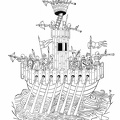Built in 1765. 2162 tons.
The Battle of Trafalgar
After twenty-five days in England, Nelson took command off Cadiz on September 28, eager for a final blow that would free England for aggressive war. There was talk of using bomb vessels, Congreve's rockets, and Francis's (Robert Fulton's) torpedoes to destroy the enemy in harbor, but it soon became known that Villeneuve would be forced to put to sea. On October 9, Nelson issued the famous Memorandum, or battle plan, embodying what he called "the Nelson touch," and received by his captains with an enthusiasm which the inspiration of the famous leader no doubt partly explains. This plan, which had been formulating itself in Nelson's mind as far back as the pursuit of the French fleet to the West Indies, may be regarded as the product of his ripest experience and genius; the praise is perhaps not extravagant that "it seems to gather up and coördinate every tactical principle that has ever proved effective."
- Author
- A History of Sea Power
by William Oliver Stevens and Allan Westcott
Available from www.gutenberg.org
Published in 1920 - Posted on
- Friday 7 August 2020
- Dimensions
- 877*701
- Tags
- Century:18th, Sailing Ship, Warship
- Albums
- Visits
- 1568
- Downloads
- 54
 Download Photo
Download Photo





